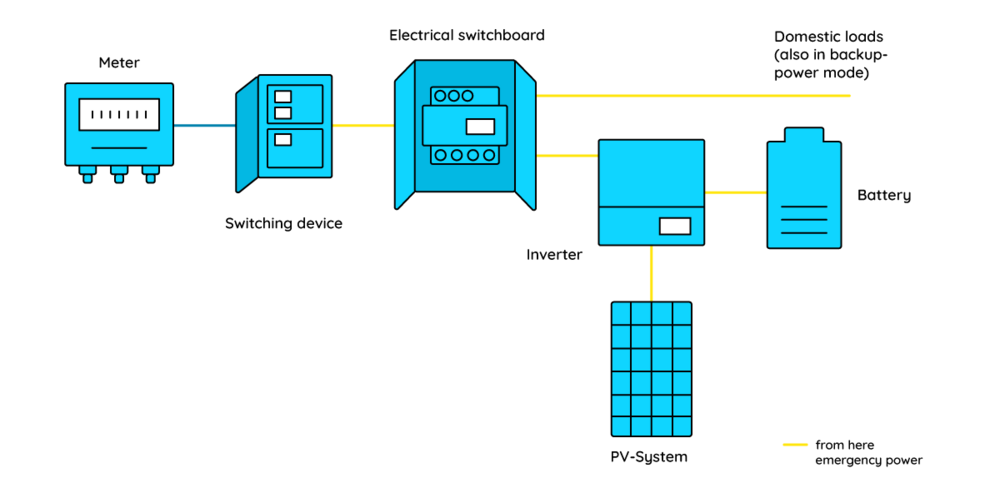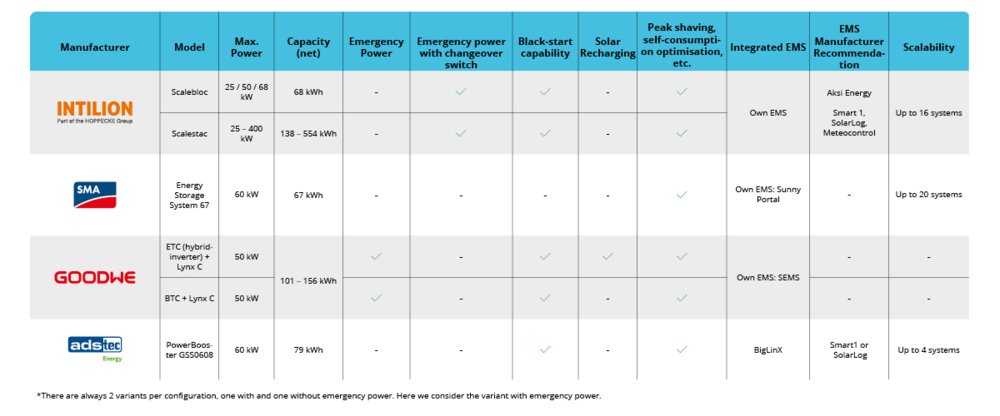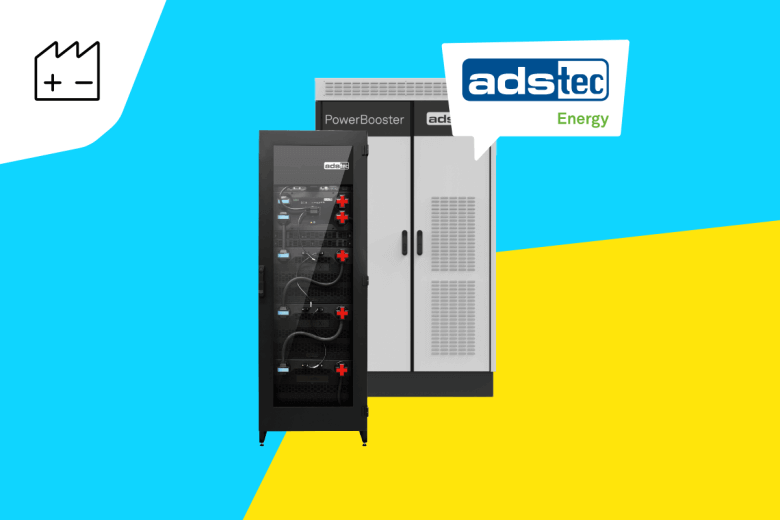From the back-up power function in the commercial sector to the planning

Emergency power, backup power, backup power light: these terms are popular in the residential sector. However in commercial and industrial sector, commercial storage systems are often used for backup power supply. Hence, it is important to pay attention to this while planning and selecting the products.
In the PV industry, emergency power (socket) and backup power – these terms are often confused. Emergency power is a 230 V socket on the side or in the battery storage (inverter), to which for example, a freezer is connected and is similar to a mobile emergency power generator.
Backup power, on the other hand, means that an intervention in the building installation must be carried out (in existing buildings) or planned for new buildings. This is achieved by means of mains disconnection device which, in the event of a power failure, disconnects the backup power network from the house connection.
If the battery-inverter system is able to supply power to all loads, it is called a complete backup power network. If the battery-inverter has less strength compared to the consumers in network, you must select which consumers will continue to operate in the event of a power failure. Here we are talking about the backup power light. These terms are used in the residential PV sector.
In the case of a battery storage system, the runtime during backup power operation can be partially extended by recharging it with solar energy. In this way, even with a reasonably designed system, those consumers that are needed for longer periods of time can be supplied with power. This functionality depends on the manufacturer and must be implemented in accordance with the data sheet and operating instructions of the respective storage system.
Backup power & commercial sector
What all commercial storage systems with a backup power function have in common is that they cannot replace an uninterruptible power supply (UPS). A UPS has 2 power units, one is parallel to the grid and is used to recharge a battery and the other unit builds up a network in the form of an inverter. This makes them useful for critical infrastructures such as data centers or hospitals.
In contrast, commercial storage systems with backup power function have only one inverter, which normally operates in parallel with the grid. If the grid fails, an external peripheral device detects this and ensures that the backup power supply starts. Only after a successful test, the battery inverter establishes a backup power grid. The whole procedure takes a few seconds. Typical applications include animal husbandry, cold storage or sewage treatment plants. Normative requirements are described in, among others, VDE-AR-E 2510-2.
A commercial storage system with backup power functionality can also be use together with a combined heat and power (CHP) unit, as CHP units can usually only operate in parallel with the grid. In this way, the running time of the backup grid can also be extended in winter. There is no need to oversize the storage for this case.
Our commercial storage systems comparison
Sometimes choosing the right storage system is not so easy: different technical requirements and the feasibility have to be balanced. Here we explain the technical differences:
The GoodWe commercial storage systems have an integrated emergency power function. The Intilion systems can be retrofitted with a switching device. Important to know: Not all consumers should be connected via a switching device. In most cases, it is perfectly sufficient to supply important selected consumers in the event of a power failure.
This year, Ads-tec Energy will launch two more commercial storage systems, an outdoor storage system and an indoor storage system. Both will have an integrated emergency power function. What’s more, the BYD Battery-Max Lite will also be available for order this year.
During planning
Planning a backup power grid with a commercial storage system is not a simple task. Basically, precise information is needed about the loads to be supplied. The keyword here is inrush currents. "During project planning, the inrush currents, especially of rotating loads, are often underestimated. Sometimes these are 8 times the nominal current and must be taken into account when dimensioning the storage system," explains Pascal Lefarth, Technical Manager C&I-Storage Solutions at Intilion AG.
These inrush currents are used as a basis for designing such a system. Most of the commercial storage systems with a backup power function can support a short-term overload; this is specified in the data sheet. If the maximum overload is exceeded, no backup power system can be set up.
This could be solved by using star-delta circuits, frequency converters and time-delayed switch-on of electric motors. These can significantly reduce inrush currents, but also at a higher investment cost.
In most cases a complete backup power supply for a industrial/commercial site is neither economical nor necessary. If it is sensible to build a backup power low-voltage main distribution, you can connect the really needed machineary or building parts on it. The power connection for the battery normally works in TNC-S-, TNS- und TT-networks only.
It is not only too many consumers that can cause a problem, but also producers. Solar recharging is possible as described before, but the power of the PV inverter should not exceed the overload power of the battery inverter. If there is a storage retrofit and there is a PV system that is larger than the storage system, you can connect individual PV inverters to the backup low-voltage distribution system. In this way, the storage system will not be overloaded and the solar recharging will also be possible.
When intervening in the existing system (> 135 kVA with medium voltage connection), a new system certificate is required.
Conclusion
The primary use cases for a commercial storage system are self-consumption optimisation and/or peak shaving. For backup power, a "reserve" must always be kept in the storage system, leading to an increase in the size of the storage system. For an economic solution, the damage that a power failure could cause must be compared with the purchase costs of the storage system.
A reasonable backup power system should be always designed individually, which requires additional planning efforts. An on-site visit is strongly recommended for existing systems. Also, a load curve should be available or a measurement of the actual peak power should be done. Alternatively, the system can be designed on the basis of the available data sheets.
In summary
- We explain products using these terms: emergency power, backup power, backup power light. Commercial storage system with backup power function cannot replace a UPS.
- We offer commercial batteries from GoodWe, Ads-tec, SMA and Intilion. They offer a wide range of product features.
- The inrush currents of the loads to be supplied serve as a basis for planning a commercial storage system with a backup power function.



